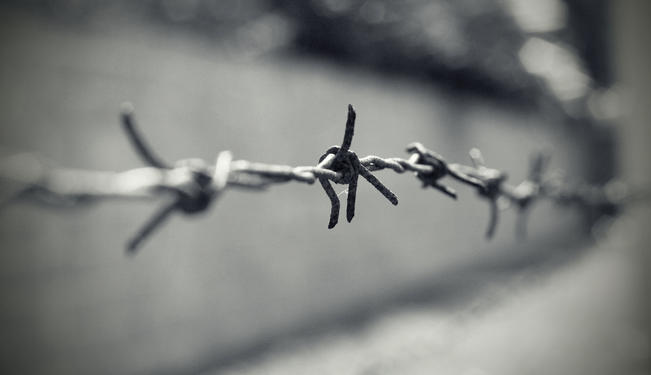To mark Holocaust Memorial Day, a look at one of the Third Reich’s nearly-forgotten death machines.
This year marks the 75th anniversary of the Third Reich’s invasion of Poland — a date when most scholars argue that, under the cover of total war, Nazism’s so-called “Final Solution of the Jewish Question” commenced.
Some, with good reason, date the onset of the Holocaust to Adolf Hitler’s seizure of power on January 30, 1933, or alternatively to the announcement of the Nuremberg Laws that legally stripped German Jews of citizenship in September 1935. Still others adjudge the onset of the Holocaust to be the systematic mass killing of Jews following the invasion of the Soviet Union on June 22, 1941, or even later with the Third Reich’s interagency streamlining of industrialized genocide, formally agreed at the Wannsee Conference on January 20, 1942.
These and other considerations remain the stuff of historical debate, on the basis of shifting constructions of what the Holocaust entailed — such as, for instance, whether other groups, like Roma and Sinti travelers and the disabled, should be interpretatively included within the term.
But one thing all genuine students of the Shoah agree upon was that it happened, crushing the lives of some 6 million European Jews under the Nazis’ jackboots. Studying these events — explaining the trajectory of genocide, documenting and remembering them — is a valuable act that serves to remind humanity of its own, all too recent, nadir. There can be no doubt: the age of shameless barbarism returned to the heart of “civilized” Europe. Simply put, this series of casually-interrelated actions represents a caesura in human history.
“Euthanasia Program”
In stark contrast to Auschwitz-Birkenau, one central Holocaust site has not often been covered in historical literature. It has been overlooked for several reasons.
The death camp at Bełzec was the first site in history that was designed to kill human beings in an industrial manner and on an unparalleled scale. During the Second World War, the Third Reich deployed gassing and mass-cremation technologies in order to turn millions of victims into ash. In this sense, the Reich’s earliest extermination camp at Bełzec remains a low-water mark in human relations with one another. Internecine wars and savagery have always pockmarked human history. But never before had mass murder and modern technology come together to provide a purpose-built, self-contained, assembly-line operation for the destruction of an entire people.
Of the death camps, known collectively as “Operation Reinhardt,” Bełzec was the earliest constructed. It was joined by Sobibor and Treblinka later in 1942, and managed this genocidal process brutally, yet bureaucratically. In the months following Operation Barbarossa, Nazi Germany’s invasion of the USSR, mass shootings in the east had proven unsatisfactory and difficult to keep secret. Expertise and personnel were then engaged from an earlier gassing program, also using carbon monoxide gas, which had seen more than 72,000 people murdered over the preceding two years.
In a grisly process of trial and error, technicians from the euphemistically entitled “Euthanasia Program” — for these were anything but mercy killings — helped to develop mobile gas vans as well as the first stationary gas chambers for Jews from the Warthegau region, who were murdered in the converted palace at Chelmno.
By the end of 1941, with the construction of Bełzec about halfway completed, the Nazi leadership had decided upon a process of total destruction — one whereby European Jews would be gassed, pillaged and disposed of, preferably in a secluded place next to a main railway line in Nazi-occupied territory.
It was this method, built from scratch and further refined over the coming months, which was to be first “perfected” at Bełzec in June 1942. Victims were sometimes murdered at a rate of 5,000 persons a day or, in hermetically sealed chambers, the bodies piled into overcrowded trains before reaching their final destination, with their corpses pillaged for valuables after being gassed. Later the bodies were burned – these had been buried in mass graves at first, before trial and error made this more efficient – over an enormous human grill, also designed by the overseers of the “Final Solution to the Jewish Question,” Heinrich Himmler’s Schutzstaffel, or SS.
This uniquely insidious project was directed primarily at the Jews of Europe. One of the very few survivors from Bełzec, an enslaved worker named Rudolf Reder — kept barely alive as a camp handyman prior to escaping — established as early as 1946 that “Bełzec served no other purpose than that of murdering Jews.” After witnessing thousands of his fellow Jews from Poland being sent to their deaths, some he knew well, Reder recalled:
“Words are inadequate to describe our state of mind and what we felt when we heard the terrible moans of those people and the cries of the children being murdered. Three times a day we saw people going nearly mad. Nor were we far from madness either. How we survived from one day to the next I cannot say, for we had no illusions. Little by little we too were dying, together with those thousands of people who, for a short while, went through an agony of hope. Apathetic and resigned to our fate, we felt neither hunger nor cold. We all waited our turn to die an inhuman death. Only when we heard the heart-rending cries of small children – ‘Mummy, mummy, but I have been a good boy’ and ‘Dark, dark’ – did we feel something.'”
This inhumanity was meted out to a minimum of 434,508 people at Bełzec, nearly all of them Polish Jews. According to a recent debate in the pages of East European Jewish Affairs, the real number is probably much higher — perhaps 600,000 Jews were murdered there, or even 800,000.
Who knows, for instance, how many unregistered trains, containing some 50 boxcars filled with thousands of terrified Jews, were diverted to Bełzec during the height of its activity in summer-autumn 1942. Affixing a precise number of victims is as impossible as imagining the individual fate of Jews suffocated at one of the principal charnel houses of the Holocaust — and indeed in human history — in Bełzec.
Operation Reinhardt
Notwithstanding this staggering reality, relatively little has been written to date on Bełzec by scholars in English. This is borne out by the scattered references to Bełzec in excellent studies on the Holocaust that have been recently published by Christopher Browning, Saul Friedländer and Peter Longerich.
One reason for this is the relatively stronger documentation left behind at other extermination camps such as Auschwitz-Birkenau — where more than a million Jews were killed, before the SS beat a hasty retreat from the advancing Soviet forces.
Another factor is clarified by the small number of survivors from Bełzec. Moreover, another reason is the sheer scale of the Final Solution, involving not only the gassing of Jews in their millions, but extended to further deaths through mass shooting, starvation and overwork. That is to say, even the most detailed and comprehensive accounts of the Holocaust have but scratched at the surface of Bełzec’s horrors.
An important exception to the limited Anglophone scholarship on Bełzec is provided by Yitzak Arad’s work on the Operation Reinhard camps. Published in 1987, his groundbreaking Bełzec, Sobibor and Treblinka added new insight into the day-to-day running of the camps comprising Operation Reinhard (sometimes the camps Chelmno and Majdenek are also included in this grouping).
Like the other two main Reinhard death camps at Sobibor and Treblinka, Bełzec comprised four groups of people: Jewish victims; a contingent of around 100 mass murderers (SS guards, Ukrainian auxiliaries and auxiliary administrative staff on site); Jews taken from transports to help with extermination process, who only lived a day or two; and so called Hofjuden (court Jews), who acted as tailors, carpenters and other skilled workers serving the camp personnel for a period of months before being murdered.
Reder was only able to escape because he was in the latter category. For the murderers, in turn, deceit and speed were central to the process in order to blunt resistance and the chances of escape; this also “increased the killing capacity of the camp.”
Finally, one particularly chilling feature shared by all three death camps is raised by Belzec, Sobibor and Treblinka: songs by orchestral musicians, often playing to drown out the screams of those murdered by gas or shooting. Arad writes:
“In Bełzec there was a small orchestra, which was used primarily during the transports and to entertain the SS men during their nights of drunkenness and debauchery. The orchestra was made up of six musician and usually played in the area between the gas chamber and the burial pits. The transfer of corpses from the gas chambers to the graves was done to the accompaniment of the orchestra.”
The Holocaust in the Soviet Union is Arad’s most recent and ambitious account, which also sheds new light on the Operation Reinhard camps. He devotes a chapter to Bełzec here, emphasizing that deportations took place largely from the Polish region of Galicia in the General Government – an area first occupied by the USSR between September 1939 and June 1941 — lasting over a period of seven months.
Although the Bełzec death camp existed between mid-March and mid-December 1942, a six-week pause was undertaken to expand the killing facilities: six concrete gassing chambers were installed to murder as many as 2,000 Jews at a time. Thereafter, in the six months comprising the “big deportations” to Bełzec, more than 100,000 transported Jews could be murdered in the course of a single month.
Yet in spite of Arad’s exceptional contribution to understanding Bełzec, and the history of Operation Reinhard more generally, Dieter Pohl rightly maintained in a pivotal 2004 collection on historical interpretations of the Holocaust that the “three camps of the Aktion Reinhard, Bełzec, Sobibor and Treblinka, became, from the spring of 1942, the murder sites of almost half of Polish Jewry, but no scholarly camp monograph has yet been published.”
This has been recently remedied with English-language studies in the cases of Sobibor and Treblinka, but not for the earliest of the Operation Reinhard camps, Bełzec.
In this sense alone, one independent scholar’s contribution to Holocaust studies is worthy of recognition. Over his years of privately-directed work, Chris Webb has collected a number of contemporaneous photographs from Bełzec — some of which are included in his self-published book, Bełzec: The Death Camp Laboratory. Relevant transcriptions from a wartime newsletter called the Polish Fortnightly Review; wartime diaries and subsequent memoirs’ excerpts from post-war testimony and trials; as well as sketches and reproductions of Bełzec, are also included in his recently published book. Intended for a general audience, both the selection and narrative are intended to give an overview, an impression, of Bełzec’s development and function. Images of the perpetrators are given prominent place — these few orchestrated the murder of hundreds of thousands of men, women and children.
The Duty, and Honor, of Remembrance
Drawing upon a leading Holocaust education website — H.E.A.R.T. — that he co-directs with Carmelo Lisciotto, Webb’s book provides details of Austro-German SS personnel at Bełzec, in addition to many of the Ukrainian and so-called volksdeutsche auxiliaries also serving in the extermination center.
These and other efforts have a very publicly-spirited effect. Amongst many others continuing to show us what actually happened less than a lifetime ago, Webb reminds his readers that, at Bełzec, the worst was perpetrated against defenseless Jewish victims, again and again.
Taken together, the patchwork of quotations, pictures, and testimony comprising his book serves to reinforce the impression that human depravity passed a certain threshold at that point in history. Quite simply Bełzec: The Death Camp Laboratory, and honorable works like it, collectively offer a glimpse of this abyss, when genocide was streamlined; administered and employed against enemies of the Third Reich for no other reason than that they were Jewish.
These and other findings are part of a lifetime’s dedication to making the Holocaust — and specifically the part played by the death camp at Bełzec in this process of genocide — better known to a wider audience.
Such private and honorable endeavors are needed today more than ever. Despite the crafted idiocies and invariable ideological extremism of Holocaust deniers — cynically, mistakenly, referring to themselves as mere “revisionists” — the wartime Holocaust remains amongst the best-documented crimes of this, or any, historical period.
This is in spite of the Nazis’ attempts, late in the war, to cover up their genocide. In Bełzec, as with other sites of mass murder comprising Operation Reinhardt, this entailed razing the camp and placing a farm, replete with a Ukrainian family as a cover story, over the human remains of its pitiless existence.
That deniers take their cue from unsuccessful Nazi attempts to hide all evidence should be always borne in mind. For who denies the Norman Conquest in 1066, or the Boston Tea Party, and so on ad infinitum, for which far less evidence exists? The answer is none, for there is no sinister reason to do so. There is nothing to gain.
That is not the case with Holocaust deniers, who overwhelming seek to rehabilitate the public image of the Third Reich, to legitimize what has rightly been called eliminationist anti-Semitism. Long may their machinations continue to fail in the face of documentary evidence and eyewitness testimony.
As we commemorate Holocaust Memorial Day on January 27 (the date of the Soviet liberation of Auschwitz-Birkenau) each year, long may these events be remembered, as both human curse and warning against hatred in all its forms — including that invidiously seeking to deny our common past.
The views expressed in this article are the author’s own and do not necessarily reflect Fair Observer’s editorial policy.
Image: Copyright © Shutterstock. All Rights Reserved
Support Fair Observer
We rely on your support for our independence, diversity and quality.
For more than 10 years, Fair Observer has been free, fair and independent. No billionaire owns us, no advertisers control us. We are a reader-supported nonprofit. Unlike many other publications, we keep our content free for readers regardless of where they live or whether they can afford to pay. We have no paywalls and no ads.
In the post-truth era of fake news, echo chambers and filter bubbles, we publish a plurality of perspectives from around the world. Anyone can publish with us, but everyone goes through a rigorous editorial process. So, you get fact-checked, well-reasoned content instead of noise.
We publish 2,500+ voices from 90+ countries. We also conduct education and training programs
on subjects ranging from digital media and journalism to writing and critical thinking. This
doesn’t come cheap. Servers, editors, trainers and web developers cost
money.
Please consider supporting us on a regular basis as a recurring donor or a
sustaining member.
Will you support FO’s journalism?
We rely on your support for our independence, diversity and quality.







Comment